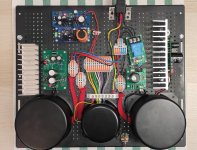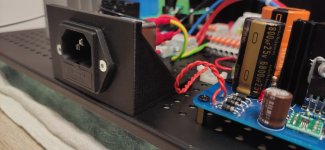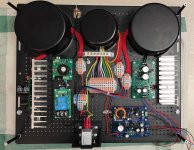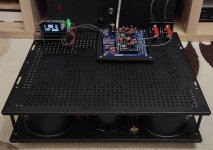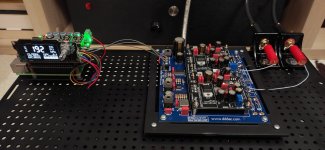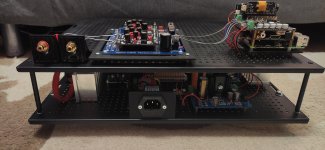Not sure what you mean by this. The DDDAC does not have it's own clock or oscillator on board. The DAC chips just ride on the timing of the incoming signal....to clock the DDDAC...
But how the incoming signal have clock/timing? It is on a seperate connector on fifopi, named: MCLK
MCLK is master clock for DACs which do not work on I2S input. For DDDAC the BCK (or SCK) input contains the clock signal. Just ignore in this case the master clock
I agree with many before me that the mainboard LF50 upgrade is def worth it.

These lt3042 regulators I mounted instead of the LF50 and LF33s on the mainboard. I did do it all at once but after two days of listening I can easily say it's better, more so in imaging.
Be aware, I use SPDIF (SHD studio source), hence the LF33 replacements. Which of the three contributes the most I can't tell😉
These lt3042 regulators I mounted instead of the LF50 and LF33s on the mainboard. I did do it all at once but after two days of listening I can easily say it's better, more so in imaging.
Be aware, I use SPDIF (SHD studio source), hence the LF33 replacements. Which of the three contributes the most I can't tell😉
The DDdac sounds very good on every sample frequency, it all depends on the quality of the recording to be honest 😉
Yes. Sample rate is not so imporant overall. It all depends on the recording quality. There are many 44.1 kHz recordings that sound better than much of the high-resolution stuff.Do you guys (and girls 🙂 ) like the DDDAC sound with 44.1KHz music?
I agree, in specific after installing the 5,6MHz Andrea clock, 44.1 is really really good - as long as the recording is top of course
Ahh, the clocks... there is still room for improvement in my DDDAC. What's the easiest way to get an Andrea clock or similar installed?
Buy the SC clocks from Iancanada. Plug and play. Audiophonics in France have them also. Very good clocks, but be patient the first 10 days, after that the magic begin. I like them very much.
Why should he buy Iancanada clocks? Documented performance is worse, then are they available at all in the low frequency versions? Did you confront these clocks directly?
No I have not even concider the Mori clocks since I want it simpel and clean, without several boxes and cables.
That is your problem..🙂 I don't see why should somebody, aiming for quality, "don't even consider" them. Pragmatic decisions are a different matter.
I'm also thinking about better clocks for my DDDAC and not sure which way to go. Easy variant would be SC-Pure for sure. Maximum performance Andrea clocks!?? Which parts would I need for Andrea clocks? 2 SinePi for FifoPi!? 2 Clock board and PSU!? And some are talking about doublers. Very confusing for me at the moment. Can someone please share a simple part list? How much would be such Andrea SetUp? Sc-pure is about 450€ for two clocks covering all sample rates.
Last edited:
I wrote a series of 6 blogs about the clocks…. nr 6 the final version of the Andrea mori clocks and a build description on how to make an automated clock / doubler switch etc
Finally I finished the DAC 😀
Here are some pictures.
Stack on stack 🙂
The bottom part contains the PSU boards, toroids with shielding cover on them and the relay switch for the power of RPi + DDDAC.
The left PSU with heatsink is 12V capacitance multiplier type linear supply for DDDAC. The right one is the same but with 5V output for RPi4.
Also there is a 3.3V superregulator for FifoPi Q7 clean side and a 5V one for the ReceiverPi Pro II.
The FIFO Q7 PSU remains under power 7/24 to keep the XO warm. In the future the ReceiverPi Pro II will switch this relay too if SPDIF signal is detected.
On the upper plate there are the DDDAC and the Ian stack.
All the power wires pass through rubber rings to keep the wire insulation safe.
Here are some pictures.
Stack on stack 🙂
The bottom part contains the PSU boards, toroids with shielding cover on them and the relay switch for the power of RPi + DDDAC.
The left PSU with heatsink is 12V capacitance multiplier type linear supply for DDDAC. The right one is the same but with 5V output for RPi4.
Also there is a 3.3V superregulator for FifoPi Q7 clean side and a 5V one for the ReceiverPi Pro II.
The FIFO Q7 PSU remains under power 7/24 to keep the XO warm. In the future the ReceiverPi Pro II will switch this relay too if SPDIF signal is detected.
On the upper plate there are the DDDAC and the Ian stack.
All the power wires pass through rubber rings to keep the wire insulation safe.
Attachments
- Home
- Source & Line
- Digital Line Level
- A NOS 192/24 DAC with the PCM1794 (and WaveIO USB input)
